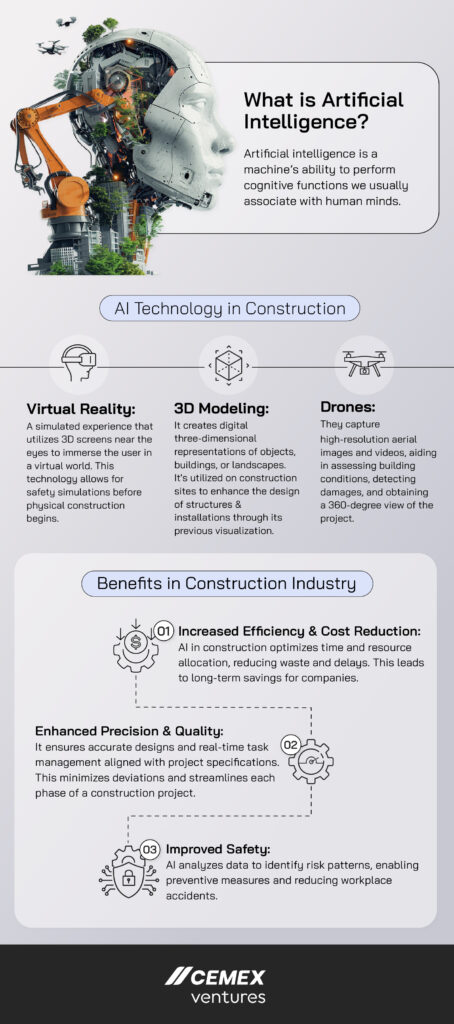Imagine an industry where project delays are predicted with uncanny accuracy and workplace injuries are anomalies. This isn’t a fantasy; it’s a potential reality.
The integration of artificial intelligence (AI) in the construction industry is currently undergoing a digital revolution, and we’re not the only ones saying it, the data speaks for itself. The artificial intelligence in construction market size this year alone is estimated at US$3.9 bn and is expected to reach US$11.8 bn by 2029. North America currently holds the title as the largest market, while the Asia Pacific region emerges as the fastest-growing player in this dynamic landscape.
Let’s delve deeper into this new technology and explore the challenges it faces in the building sector. We’re building the future, one algorithm at a time.
The AI revolution in construction
Artificial intelligence, which emerged in the 1950s, has unlocked unprecedented potential in recent years in the construction sector. Companies are capitalizing on its benefits while also addressing the challenges it may entail. Here are some ways AI can make a difference in construction:
Safety first: AI’s watchful eyes
Safety is a top priority for business owners, especially in construction. Fortunately, AI offers advanced solutions to enhance jobsite security:
- Robots can operate in challenging working conditions that might pose health hazards or danger to human workers. For example, robots can be used to complete tasks in environments where harmful chemicals are emitted during production, thereby safeguarding employee health & safety.
- Powered Vision Technologies incorporate facial recognition features to monitor workers’ expressions. They can detect signs of fatigue, such as yawning or lowered eyelids. This is particularly useful for workers engaged in repetitive tasks.
Smarter planning & design
The planning and design phase is undergoing seismic changes, all thanks to the application of AI! Here’s how it’s reshaping the industry:
- Enhanced creativity: AI-powered software assists architects and engineers to think beyond the ordinary. By analyzing vast data sets, AI-driven software generates alternative design options, like digital brainstorming.
- Efficiency boost: AI-driven planning tools can analyze historical project data to optimize budgeting & construction schedules to prevent delays and additional costs. For example, by evaluating historical costs of materials and labor, more accurate budgets can be generated.
Project and jobsite management
Artificial intelligence in construction project management significantly streamlines tasks, automating routine activities like progress tracking and resource allocation.
For instance, in the context of human scheduling, project managers input workers’ information, work experience, and relevant project-related documents. New AI system process this data, assisting them in assigning tasks to employees based on their availability and work experience.
Another clear example is that project managers could input data on weather forecasts, equipment availability, and site conditions. AI could analyze this data to optimize construction processes, considering weather constraints and equipment availability.
Enhancing quality control
Intelligent sensors are installed in buildings to monitor vibrations and movements and detect any anomalies. These tools accurately identify defects and deviations from design specifications, significantly improving quality control.
AI can also help improve construction quality by checking the quality of construction materials and components. The result is stronger and more reliable structures.
Predictive maintenance: A game changer
You might wonder if artificial intelligence and predictive construction maintenance truly complement each other. The answer is a resounding yes.
Predictive maintenance models use data from AI sensors in construction machinery, like engine temperature, vibration, and usage patterns, to schedule repairs when they’re most needed and streamline operations.
Image recognition
Artificial intelligence tools (drones, 3D imaging) enable:
- Precision checks: By using 3D images, engineers can compare the progress of ongoing construction against initial plans, ensuring alignment at every stage of the project without unforeseen surprises.
- Design optimization: AI can analyze aerial images captured by drones to assess construction site conditions. With that information, it provides valuable advice to architects during the construction phase. It’s like having a high-tech assistant.
- Virtual tours: Imagine investors visiting skyscrapers virtually! Panoramic images captured on-site by remotely controlled cameras allow them to visualize the completed project.
Exploring the downsides: Challenges in construction
High initial costs
Applying cutting-edge AI technology to construction projects involves significant upfront investment. For instance, developing a tailored model to optimize schedules for a specific construction project entails significant costs for data preparation, the installation of customized hardware, and skilled personnel to manage the software.
Ethical and legal regulation
This revolutionary field can pose ethical and legal risks, such as biases, discrimination, accountability, and transparency. Governments play a crucial role in ensuring responsible and reliable adoption of this technology across all sectors. It will become increasingly necessary for policy leaders to establish clear and coherent frameworks and standards, like the European Union, which regulates its use through the 2022 Artificial Intelligence Act.
Data privacy and security
Artificial intelligence thrives on robust datasets. To operate effectively, companies must ensure data quality, accuracy, and accessibility. But there’s a catch: sharing data can incur risks, including cyberattacks and privacy breaches.
Construction companies & startups must fortify their cybersecurity defenses, shielding valuable information from unauthorized access. Measures such as backing up data and installing security software can help mitigate these risks.
Cemex Ventures improves AI in the construction industry
At Cemex Ventures, we’re looking to invest in the leading AI startups solutions that have the potential to reshape construction. DroneDeploy & Vizcab are prime examples of high-potential artificial intelligence applications in construction within our investment portfolio.
DroneDeploy
In 2018, Cemex invested in DroneDeploy, previously known as StructionSite, that is redefining the future of reality capture in the construction industry.
The California-based startup assists construction companies in automating the process of reality capture using various technologies such as drones, robots, and 360 cameras. By consolidating this data onto one platform, DroneDeploy enables AI-powered analyses. It offers a myriad of services, from aerial and ground views to track construction progress to automated gauge readings and methane leak detection.
Vizcab
In 2023, Cemex invested in Vizcab with the aim to reduce construction’s CO2 footprint. The French startup has developed a powerful AI-based Software as a Service (SaaS) platform that enables various developers and professionals in architecture, engineering, and construction (AEC) to assess and work towards reducing CO2 emissions throughout the construction value chain.
Does your business have an AI-powered solution that can revolutionize our industry? Apply today to Construction Startup Competition 2024, and let’s build something bigger together!




